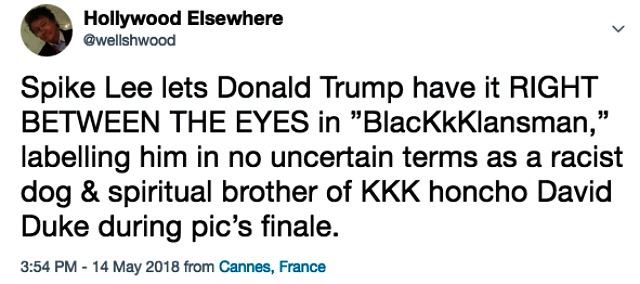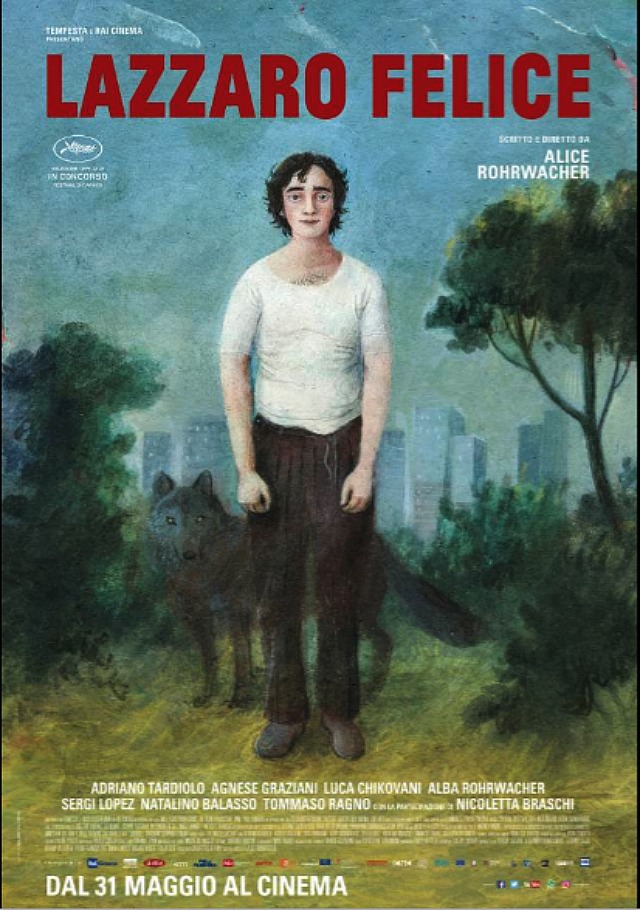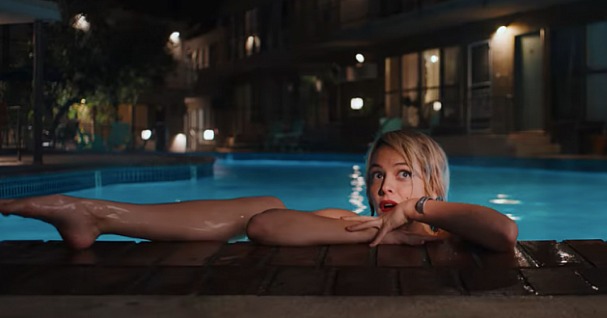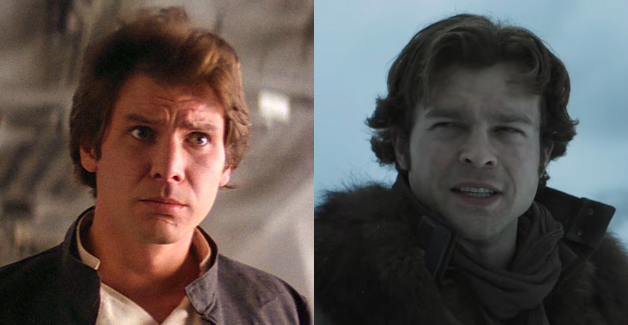 Jeffrey Wells
Jeffrey Wells
Mitchell’s Wandering Fartscape
I’m sorry but David Robert Mitchell‘s Under The Silver Lake (A24, 6.22), which I saw early this morning, is mostly a floundering, incoherent mess. Yeah, I know — Mitchell wanted it to feel this way, right? Ironically, I mean. Confusion and mental haziness were part of the impressionistic thrust.
It’s pretty much a textbook example of what happens when a gifted, financially successful director without much on his mind at the time…this is what happens when such a fellow comes to believe that he’s a version of Federico Fellini in the wake of La Dolce Vita or 8 1/2 and thereby obtains the funds to make whatever the hell he wants, and so he decides to create…uhm, well let’s try our hand at an impressionistic fantasia dreamtrip about L.A. hipster weirdness and…you know, dreamy fantasy women with nice breasts and impressionistic effluvia and whatever-the-fuck-else.
Two hours and 15 minutes of infuriating slacker nothingness…everyone’s vaguely confused, nobody really knows anything, all kinds of clues and hints about seemingly impenetrable conspiracies involving general L.A. space-case culture, bodies of dead dogs, cults, riddles and obsessions of the super-rich.
It’s basically about Andrew Garfield absolutely refusing to deal with paying his overdue rent, and neighbor Riley Keough, whom he tries to find throughout the film after she disappears early on, doing a late-career Marilyn Monroe with maybe a touch of Gloria Grahame in In A Lonely Place.
Under The Silver Lake is Mulholland Drive meets Fellini Satyricon meets Inherent Vice meets The Big Lebowski, except Lebowski, bleary-eyed stoner comedy that it was, was far more logical and witty and tied together, and with an actual through-line you could more or less follow.
I felt the same kind of where-the-fuck-is-this-movie-going?, wandering-fartscape confusion that I got from Paul Thomas Anderson‘s adaptation of Thomas Pynchon‘s novel of the late ’60s.
During the press conference Mitchell described Silver Lake as a “fever dream.” He said he wrote it fairly quickly, and that it began with his talking about his wife about “what’s really going on in those swanky-looking houses up in the L.A. hills?”
“Oh, No…This Stuff Again”
I saw Solo: A Star Wars Story (Disney, 5.25) earlier this evening at the Salle Debussy. A Han Solo origin story, and I really don’t give a damn about this heavily-milked realm. Same old “a long time ago,” same old dashing heroics, same old quips, same exotic creatures, same high-throttle chase scenes…formula, formula, plop-plop, fizz-fizz
How many years or decades does Disney plan on cranking out the same old sausage? The answer is “forever.” Six years ago
What did I get out of watching this light-hearted, fast-moving but rote-feeling Ron Howard flick, which attempts to reanimate the legend and spirit of Han Solo? HE regulars are sick of me saying that the rakish smuggler and adventurer has been personified by Harrison Ford for the last 42 years, but is now owned and operated by Alden Ehrenreich, whom I regard as “Little Han.”
The answer is “Not much, man…not much at all.”
Seriously, I never felt turned on or lifted up or caught up in the flow of the thing, and I’m saying this as someone who half-enjoyed The Force Awakens, felt mildly engaged by Rogue One and was half-taken by portions of The Last Jedi.
I just can’t respond to this stuff any more. I couldn’t take the plunge. I was muttering to myself “oh, Jesus, c’mon…they’re shovelling and recycling the same crap here, over and over and over.”
I’ve said this seventeen or eighteen times, but Ehrenreich is Han Solo’s shorter wannabe cousin — a guy who’s trying like hell to fill Han’s boots but who lacks fundamental Hannitude. And in this context, he really is part of Short People Nation. Shorter than Woody Harrelson, way shorter than Chewbecaa, not much taller than Emilia Clarke (who looks kind of odd in a chubby-faced way), and always looking up at everyone, like he’s some kid in seventh grade.
Yes, Ehrenreich does a good job of pretending to be a young Han, and if you want to go along with this charade, be my guest. AE gives it everything he has, applying the acting lessons he was given during principal photography, but the effort simply doesn’t work. There’s no escaping the fact that he’s nowhere close to being a chip off the old block.
Vile Dog
Trump’s slightly rising poll numbers are apparently over the perception that his tough-guy diplomacy resulted in North Korea folding its hand and agreeing to conciliatory peace talks. Whatever the truth of it, it’s appalling how easily and quickly certain persons can be turned.

Heterosexual Maestro
Reactions?
Rami Malek takes on Freddie Mercury in the first official trailer for the Queen biopic 'Bohemian Rhapsody.' pic.twitter.com/PBScwl2i77
— Hollywood Reporter (@THR) May 15, 2018
Loathsome “Jack” Is Dryer, More Meditative Than Expected
I’m not saying Lars von Trier‘s The House That Jack Built isn’t repellent in more ways than you can shake a stick at. It’s an odious, ice-cold exercise in homicidal perversity, and one for the record books at that. It should probably be avoided by anyone with a weak stomach or…oh, hell, by anyone who feels that films should exude some form of love or worship or celebration, which probably covers 99% of the moviegoing public.
But after last night’s build-up (tweets conveying disgust and rage, reports of people walking out of the black-tie premiere) I was expecting a diseased horror-murder tale so excessive that it might make me physically sick or prompt me to walk out or get into a fight with one of the security guys.

It didn’t do that. It turned out to be more of a meditative guilt confessional — about LVT more or less admitting that he may not be a good enough artist to deliver worthy, lasting art, and that all he really knows how to do is shock and agitate. (That’s what I got from it, at least.) I’m not saying it’s a better film than I expected, but it’s dryer and more meditative and not as heinous as I feared.
Portions of Jack are awful to sit through and the overall tone may be an equivalent to the professionally distanced, carefully maintained mindset of a psychological counselor in a hospital for the criminally insane. But for all the innate ugliness and sadistic cruelty on-screen, Von Trier is basically analyzing himself by way of Matt Dillon‘s Jack, a serial killer based in the Pacific Northwest, and casting a cold eye upon his shortcomings as a filmmaker.
Dillon is a would-be architect but is only gifted enough to be an engineer, he gradually admits. This is Von Trier talking about himself, of course — admitting to his audience that he’s “not quite Ivy League”, and that after shooting his wad on Breaking The Waves, The Idiots, Dancer in the Dark and Dogville that all he really knows how to do now is make shock-and-appall movies like this, Antichrist, the two Nymphomaniac films and so on.
I’m not saying Jack gets a pass, but at least LVT has tried to make it into something more thoughtful and meditative than just a series of clinical, cold-blood episodes showing recreations of this and that method of murder. It’s ugly and rancid, but about more than just that.
Bitterly Resigned To Not Seeing This Here
Missing this wasn’t my intention. I tried like hell. Schedule another screening between now and next Friday and I’m there.
Old Guy vs. Hipster Tuxedo Pants
Prior to last night’s screening of Chris Nolan’s “unrestored” 2001: A Space Odyssey, Nolan was joined on the stage of the Salle Debussy by costar Keir Dullea, longtime Kubrick producer Jan Harlan and Cannes Film Festival topper Thierry Fremaux. The below photo is of (l. to r.) the tuxedo pants of Dullea, Harlan, Katharina Kubrick and finally Fremaux’s. Notice how Fremaux’s slimly tailored tuxedo pants are the only ones that look hip, and how Dullea and Harlan’s are baggy and blowsy with the cuffs bunched at the cuff — the way tuxedo pants were styled 20 years ago and before. I myself wouldn’t be caught dead in tuxedo pants that look like Dullea’s and Harlan’s, but that’s me. Some people don’t care about this stuff, but you have to care.

Lee’s “Klansman” Busts Trump Like A Bitch
Spike Lee‘s BlacKkKlansman (Focus Features, 8.19) isn’t a great film, but it’s his strongest since Inside Man (’06) and before that The 25th Hour (’01), and easily his most impassioned, hard-hitting film about the racial state of things in the U.S. of A. since Malcom X (’92).
You can feel the fire and rage in Lee’s veins in more than a few scenes, and especially during the last five minutes when Lee recalls the venality of 2017’s “Unite the Right” really in Charlottesville, which ended with the death of protestor Heather Meyer, and reminds that Donald Trump showed who and what he is with his non-judgmental assessment of the KKK-minded demonstrators. Lee paints Trump with the racist brush that he completely deserves, and it makes for a seriously pumped-up finale.

But that doesn’t change the fact that BlacKkKlansman is basically a police undercover caper film, based on Ron Stallworth’s 2014 novel (“Black Klansman: Race, Hate, and the Undercover Investigation of a Lifetime”).
Nor the fact that tonally it sometimes feels like Starsky and Hutch or even to some extent like John Badham‘s Stakeout, especially as it involves the main cop protagonist falling in love with a girl (in this case an Afro’ed black activist played by Laura Harrier) who shouldn’t know what he’s up to, but whom he eventually confesses to. In this sense John David Washington‘s Stallworth is Richard Dreyfuss in the Badham film, and Adam Driver (as partner Flip Zimmerman) is Emilio Estevez.
At times the film also reminds you of some Clarence Williams III scenes from The Mod Squad.
Set in 1972, pic isn’t literally about Stallworth joining the Ku Klux Klan but a stealthy undercover investigation of the Klan, initiated when he was the first black detective in the history of the Colorado Springs Police Department.
After initial correspondence with the Klan, Stallworth received a call in which he was asked if he wants to “join our cause.” Stallworth answered affirmatively, and in so doing launched an audacious, fraught-with-peril inquiry.
SPOILER-ISH BUT NOT REALLY: Right away you’re telling yourself, “Yes, I know this actually happened and that Lee is using the facts in Stallworth’s book, but it made no sense for Fallworth to be heavily involved in this operation.” And it just feels crazy as you’re watching one crazy incident after another.
Holy Innocent
Alice Rohrwacher‘s Happy as Lazzaro, which I saw this morning at the Salle Du Soixantieme, may win the Cannes Film Festival’s Palme d’Or next weekend. It’ll almost certainly win something big as it’s quite the spiritual film, and it delivers the kind of humanist current that can lift all boats.
In this stand-up-for-women moment on the Cote d’Azur, the deciding factor, I suspect, may simply be one of gender. I’m not saying Happy as Lazzaro is a woman’s film — the spiritual current is universal and gender-less — but it’s very much a “heart” film, and I’m sensing that this plus a “let’s give the big prize to a woman director if we can” factor will penetrate.
Set sometime in the late ’80s, Rohrwacher’s third film is about a late-teen or twentysomething farmworker named Lazzaro (Adriano Tardiolo), who at first resembles a cross between a pure-of-heart innocent or, if you want to brusque about it, a seemingly charmed simpleton. But that impression changes as the film develops, especially during the second half.

While Happy as Lazarro takes place in two distinctly different realms, they share a tone of exploitive cruelty and a look at the harsh plight of the hurting poor — a rural and almost medieval tobacco farm in central Italy in the first half and a large Italian city in the second half.
The dividing line between the two is a startling event that happens halfway through, and after this the true scheme of Happy as Lazzaro kicks in.
For this is basically the story of a kind of saint who refuses to respond with even a trace of guile or calculation. Lazzaro is very much a lamb-like (or donkey-like if you consider his resemblance to the Christ-like beast in Bresson’s Au Hasard, Balthazar) figure of faith and trust, and the resulting current of kindness and compassion becomes more and more affecting.
Happy as Lazzaro is my second favorite film of the festival so far, second only to Pawel Pawlikowski‘s Cold War. It’s quite the mixture of fabulism and a certain kind of grim, social-critique drama, shot in 16mm with a hand-held, rounded-edges aesthetic.
I’m not saying Rohrwacher is copying anyone, but I felt the influence of the Taviani brothers‘ Padre Padrone and Bernardo Bertolucci‘s 1900 in the first half, and then a whole different kettle of fish (urban poverty) in the second half. But it’s always about purity vs. venality and indifference, and it’s really quite magical.
Among the costars are Alba Rohrwacher (the director’s older sister) and Spanish actor Sergi Lopez (Pan’s Labyrinth), whom I didn’t even recognize at first.
The rural portion (i.e., the first half) was shot in Bagnoregio, a small commune in the Lazio section of Italy.
I have to leave for a screening of Spike Lee‘s BlacKkKlansman, but there’s something very special, trust me, about Happy as Lazzaro.






